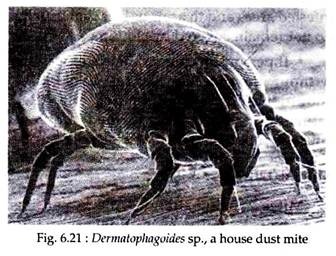The following points highlight the two main types of mites that cause allergy. The types are: 1. House Dust Mites 2. Storage Grain Mites.
Type # 1. House Dust Mites:
Many species of the genus Dermatophagoides are the main causative agents of house dust allergy. Most common species are D. pteronyssinus and D.farinae (Fig. 6.21). They are very small mites, 0.17 mm to 0.39 mm in length, short oval to nearly circular in shape, and flattened. Their skin is soft and striated.
All tarsi end in caruncles. They cause severe and persistent dermatitis. Besides, whole mites or their parts or excrement of some species when inhaled as happens to everybody everyday, they can cause asthma and other respiratory problems in sensitive individuals.
Type # 2. Storage Grain Mites:
1. Family acaridae:
ADVERTISEMENTS:
This family includes a small group of very tiny mites. They ordinarily attack grain, flour, dried meat and fruits, insect collections etc. Their development is so rapid that literally millions of them may appear in a stored product, in a few days.
The metamorphosis of this group involves a peculiar stage known as the hypopus. It appears in a number of species between the two nymphal stages, very unlike either of these and very different from the adult. This is a “wander nymph” stage in which the mites attach themselves, non-parasitically to hosts which disseminate them.
The acarid mite Acarus siro is the grain mite or cheese mite found in grain, stored product and cheese. This mite causes a rash known as “Vanillism” in vanilla pod handlers. Tyrophagus castellanii cause “copra itch” among dock workers handling copra and cheese.
ADVERTISEMENTS:
The cause of such allergic dermatitis has been variously attributed to the dust caused by the feeding mites and the microorganisms present therein; to a hypersensitivity on the part of the patients and to a substance present in the saliva of the mites.
2. Family glycyphagidae:
Glycyphagus domesticus often found in dried fruits and in such organic matter as skin and feathers, cause “grocers itch” when highly infested material is handled. This mite may occur in enormous number in homes and stores.
Blomia tropicalis is a storage mite, found in climate conditions with high humidity in tropical and subtropical countries like India, Hong Kong, Japan, Brazil, Egypt, Nigeria, Taiwan etc. The adult move in characteristic hasty fashion and has several long sitae covering the body.
ADVERTISEMENTS:
The female lay eggs randomly under nutrient particles. Larvae are seen one week after copulation and following another week, the larvae transform into adult.
In India (Mumbai), Blomia tropicalis was found to be a dominant species of the acaro-fauna in some houses, as it can thrive not only in bedding etc. but in places like kitchens too. Thus making it an important house dust mite.
A possible explanation for this could be that in many Indian homes, during summer, food- grains are purchased as an annual stock, dried in solar heat and stored. These food grains could be the vehicles allowing the entry of storage mites into the houses.
Allergens, their mode of activity in mite-borne allergy:
In recent years, scientists are trying to isolate and characterize the allergens or the factors responsible for the development of allergic reactions. House dust mite allergens have been shown to be a very important stimulus in the causation of asthma and triggers for exacerbation of symptoms.
Few cysteine proteases or group 1 allergens have been recognised as immunodominant allergens involved in dust mite specific IgE-mediated hypersensitivity. It has been proposed that proteolytic activity is the major contributor of the hypersensitivity, associated with group 1 dust mite allergens such as Der p 1 derived from Dermatophagoides pteronyssinus.
Der p 1 causes disruption of intercellular tight junctions (TJS), which are the principal components of the epithelial para-cellular permeability barrier. Such opening of TJS by environmental proteinases may be the initial step in the development of allergic asthma.
Besides this function, Der p 1 selectively cleaves human CD25, the alpha subunit of the T cell IL-2 receptor. As a result of this cleavage T helper cells show diminished proliferation and IFN-y secretion, leading to an augmentation of the TH subset and presumably, the development of allergen.
ADVERTISEMENTS:
From Blomia tropicalis, a novel allergen, homologous to cysteine proteases was isolated and was designated as Blot 1. To date, only turee Bt allergens have been isolated and cloned which were presumed to play a major role as an immunodominant allergen. It is involved in dust mite-specific IgE-mediated hypersensitivity, though their specific mode of activity is yet to be investigated.
